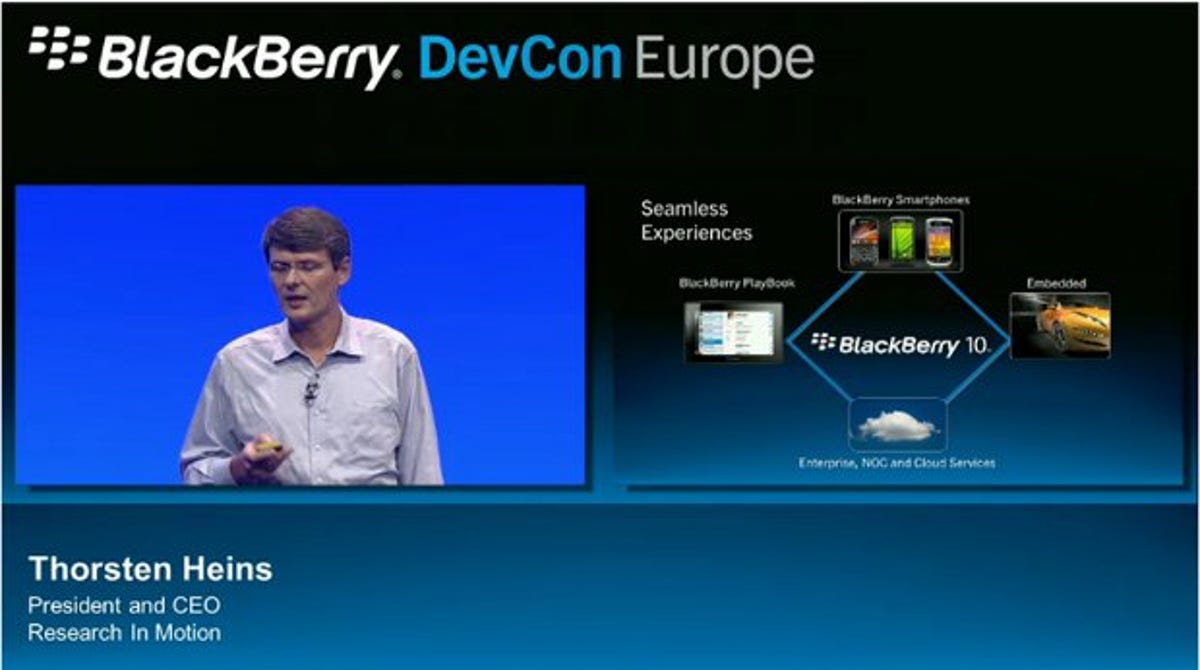
A major software update coming to BlackBerry’s PlayBook tablet later this month — PlayBook 2.0 OS — has been demoed, with whopping great hints at what’s to come later this year with BlackBerry 10.
Freshly anointed president and CEO Thorsten Heins signalled the new world order for PlayBook and gave a glimpse of the direction the company will adopt with BB10, the unified software platform for its tablet and BlackBerry smart phones.
For now, BlackBerry fanboys are stuck with BlackBerry 7 OS, as devices running BB10 won’t land until mid-2012 at the earliest. But taking the stage at BlackBerry’s DevCon conference for European developers in Amsterdam today, Heins said BB10 would have a “new user paradigm” — which roughly translates to, “It’s going to work a bit differently.”
How different exactly? Heins called the new philosophy “BlackBerry Flow” — and demonstrated it by showing off PlayBook 2.0 features, including a unified inbox, which gathers all forms of communications, email, social and so on, into a one-stop-messaging-shop on the tablet. There’s also an integrated calendar app, which draws in social info automatically to flesh out various details about the contacts and companies you’re meeting.
Heins said the basic idea being Flow is to have real-time information pushed out automatically to BB10 devices, and to avoid the need to dip in and out of different apps. At this point the word “seamless” got the inevitable unboxing.
“We want to make it effortless for the user to use all their apps and not always be having the in/out paradigm,” waffled Heins. “This is the heart of BlackBerry 10. It’s to be effortless in everything you do. It just flows.”
As well as knitting apps together to make them more get-at-able, BB10 will also hook into cloud services, Heins promised — with cars, homes and “new segments” (we assume he doesn’t mean orangeries) also getting drawn in to the BB10 mix.
The CEO revealed RIM began work on BB10 two and a half years ago and has been buying up “the best tech companies we could find” to deliver on its grand plan — name-checking QNX, for its new OS; TAT, for user interface design; TorchMobile, for its WebKit browser; Tungle for social calendaring; and Scoreloop for online scoring and gaming.
“And there’s more to come,” he added — hinting he’s in buying mood.
Burning BlackBerry Bridge
RIM also showed off how the relationship between a BlackBerry handset and the PlayBook tablet will change with PlayBook 2.0.
Currently, PlayBook owners need a BlackBerry phone to get access to BlackBerry email on the slate by using a system called BlackBerry Bridge — but this feature becomes redundant with PlayBook 2.0. Bridge doesn’t disappear though; it will be used to turn BlackBerry smart phones into a remote control for the tablet, assuming you prefer typing on a miniature keyboard rather than a larger touchscreen.
Touchscreen BlackBerrys such as the new Bold 9790 will also be able to control the PlayBook by deploying the same swipe gestures on their smaller screens using the Bridge 2.0 feature. “Think about having a PlayBook on your desk — you can control everything just on your BlackBerry,” added Heins.
RIM exec Vivek Bhardwaj also attempted to demo a photo-sharing feature that allows a BlackBerry smart phone user to “seamlessly” send a snap to the PlayBook, but was struck by demo gremlins — only a few pixels of the photo made it across the cyber-ether.
In a stats-heavy presentation, the company revealed there are now around 60,000 apps on its BlackBerry App World store, with 2 billion app downloads globally to date and 6 million downloads daily. RIM claims a lucky 13 per cent of its developers have earned more than $100,000 building App World apps.
RIM also said it now has 75 million BlackBerry subscribers worldwide and has shipped 180 million BlackBerrys to date.
Like the sound of BlackBerry 10? Potty about PlayBook 2.0? Let us know in the comments below or add your BlackBerry jam to our Facebook wall.



